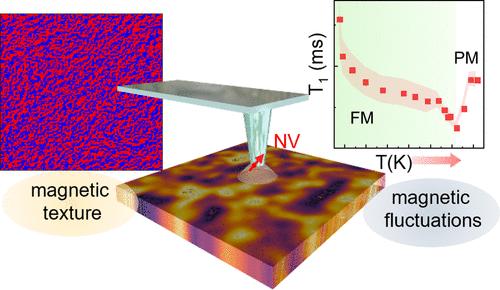高居里温度铁磁体的纳米级磁有序动力学
IF 9.1
1区 材料科学
Q1 CHEMISTRY, MULTIDISCIPLINARY
引用次数: 0
摘要
当材料接近临界温度Tc时,铁磁和顺磁相之间的热驱动转变具有不同的磁化率,远程相关性和自旋动力学的临界行为,可以跨越kHz到GHz尺度,但事实证明,用大多数传统测量技术探测相关的长度和时间尺度在技术上具有挑战性。在这项研究中,我们采用扫描氮空位中心磁强计和弛豫计来揭示高tc铁磁氧化物在居里温度附近的临界行为。对测量的温度相关纳米级磁性结构的聚类分析指出了一个三维普适类,其相关长度在Tc附近发散。同时,通过全光学弛豫测量的温度依赖自旋动力学表明相变属于XY普适类。我们的研究结果捕获了关键行为的静态和动态方面,为控制磁性材料相变的通用特性提供了见解。本文章由计算机程序翻译,如有差异,请以英文原文为准。

Nanoscale Magnetic Ordering Dynamics in a High Curie Temperature Ferromagnet
Thermally driven transitions between ferromagnetic and paramagnetic phases are characterized by critical behavior with divergent susceptibilities, long-range correlations, and spin dynamics that can span kHz to GHz scales as the material approaches the critical temperature Tc, but it has proven technically challenging to probe the relevant length and time scales with most conventional measurement techniques. In this study, we employ scanning nitrogen-vacancy center based magnetometry and relaxometry to reveal the critical behavior of a high-Tc ferromagnetic oxide near its Curie temperature. Cluster analysis of the measured temperature-dependent nanoscale magnetic textures points to a 3D universality class with a correlation length that diverges near Tc. Meanwhile, the temperature-dependent spin dynamics, measured through all optical relaxometry suggest that the phase transition is in the XY universality class. Our results capture both static and dynamic aspects of critical behavior, providing insights into universal properties that govern phase transitions in magnetic materials.
求助全文
通过发布文献求助,成功后即可免费获取论文全文。
去求助
来源期刊

Nano Letters
工程技术-材料科学:综合
CiteScore
16.80
自引率
2.80%
发文量
1182
审稿时长
1.4 months
期刊介绍:
Nano Letters serves as a dynamic platform for promptly disseminating original results in fundamental, applied, and emerging research across all facets of nanoscience and nanotechnology. A pivotal criterion for inclusion within Nano Letters is the convergence of at least two different areas or disciplines, ensuring a rich interdisciplinary scope. The journal is dedicated to fostering exploration in diverse areas, including:
- Experimental and theoretical findings on physical, chemical, and biological phenomena at the nanoscale
- Synthesis, characterization, and processing of organic, inorganic, polymer, and hybrid nanomaterials through physical, chemical, and biological methodologies
- Modeling and simulation of synthetic, assembly, and interaction processes
- Realization of integrated nanostructures and nano-engineered devices exhibiting advanced performance
- Applications of nanoscale materials in living and environmental systems
Nano Letters is committed to advancing and showcasing groundbreaking research that intersects various domains, fostering innovation and collaboration in the ever-evolving field of nanoscience and nanotechnology.
 求助内容:
求助内容: 应助结果提醒方式:
应助结果提醒方式:


